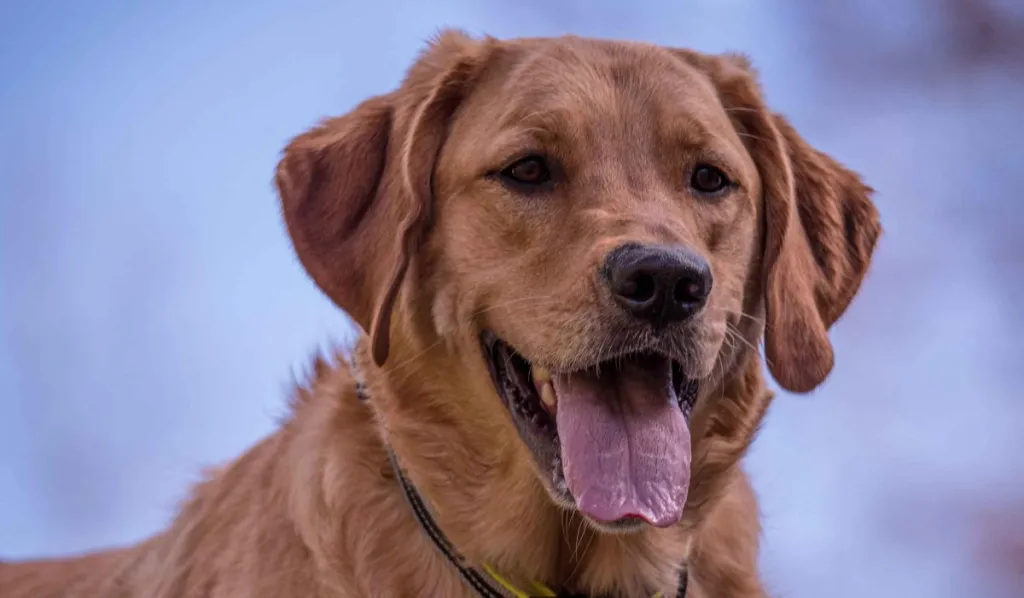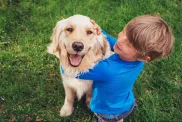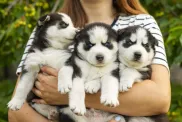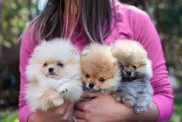The Goldador, also known as the Golden Labrador, is a hybrid dog breed that results from crossing a Golden Retriever with a Labrador Retriever. These dogs truly embody the best of two of the most popular dog breeds. They inherit the best traits from both beloved parent breeds, making them excellent family pets and service animals. Goldadors typically exhibit both Retrievers’ friendly and outgoing nature, and they easily get along with children and other pets. Regarding temperament, Goldadors are known for their intelligence, trainability, and eagerness to please, which makes them highly responsive to obedience training.
Physically, Goldadors usually have a sturdy build and are medium to large size. Their coat is often dense, water-resistant, and can come in shades of gold, cream, or yellow. Because the Golden Retriever and Labrador Retriever are both active breeds, the Goldador thrives when given ample exercise. These pups are water dogs through and through and will be happy to accompany you to any body of water you can find. You might even be surprised to watch them dive in the water, tails up! Make sure you can commit to lots of daily walks and active play sessions before you bring this mix home. If you can, you’ll have a happy, loving, and loyal member of the family.
Goldador characteritics
- Weight: 22 to 24 inches tall at the shoulder
- Height: 60 to 80 pounds
- Lifespan: 10 to 15 years
Coat and colorvVariations
The Goldador can display various coat colors and textures due to their mixed heritage. As with all breeds, it’s never certain what characteristics a dog will inherit from their parents.
Coat types:
- Short Coat: Similar to the Labrador parent, the coat may be shorter, sleek, and dense.
- Medium to Long Coat: Resembling the Golden Retriever side, the coat can be longer and wavier with a water-resistant quality.
Color variations:
- Golden: Light to dark golden, much like the Golden Retriever parent. The shade can range from cream to deep reddish-gold.
- Yellow: More akin to a yellow Labrador, this color can range from pale cream to darker yellow.
- Black: Some Goldadors inherit the solid black coat of a black Labrador. These coats tend to be shiny and sleek.
- Chocolate/Brown: A less common variation, where the dog inherits a deep brown or chocolate color from a chocolate Labrador parent.
- Mixed Coloring: Occasionally, a Goldador may have a combination of these colors, with subtle markings or shading that give them a distinct appearance.
Physical traits and appearance
Goldadors combine the best physical traits of their parent breeds, making them athletic, friendly, and adaptable dogs whose physical appearance can differ based on which parent they take after more closely.
Size and build
- Goldadors stand 22 to 24 inches at the shoulder.
- Typically, Goldadors weigh between 55 to 80 pounds (25 to 36 kg), depending on the parentage and gender.
- Goldadors have a strong, athletic build, reflecting their origins as working dogs. Their bodies are muscular, with a broad chest and sturdy legs.
- The Goldador’s tail is often thick and strong, inherited from the Labrador side. It may be straighter like the Labrador’s or have a slight wave like a Golden Retriever’s tail.
- They have well-arched and webbed feet which is great for swimming—an ability both parent breeds are known for.
Head, eyes, and facial Structure
- A broad head with a pronounced stop (the transition from the forehead to the muzzle).
- The ears are medium-sized, hanging down, and slightly rounded at the tips.
- Expressive, almond-shaped eyes. The eye color can range from brown to hazel, with a friendly and intelligent expression.
- The Goldador’s nose is typically black, though it may be brown in chocolate Goldadors.
- Some may have the characteristic “snow nose,” where the nose lightens in winter.

Goldador personality
The Goldador is known for their friendly, loyal, and intelligent personality. Both parent breeds are known for being highly affectionate and thrive on human companionship. Goldadors are extremely people-oriented, often forming strong bonds with their families. They are also highly trainable due to their intelligence and eagerness to please, which makes them excellent candidates for service and therapy work, as well as general obedience training. Their playful, energetic nature makes them great companions for active families, while their gentle, patient demeanor ensures they are wonderful with children. Goldadors are typically well-behaved with other pets and animals and are known to be sociable in various environments. However, they do best when they have plenty of exercise and mental stimulation to keep them happy and prevent boredom-related behaviors.
Temperament and behavior
- Affectionate: They are loving and enjoy being close to their human family.
- Friendly: Goldadors are generally outgoing and warm toward strangers and other animals.
- Intelligent: They are quick learners and respond well to training.
- Loyal: They form strong bonds with their owners and are protective without being overly aggressive.
- Energetic: They need regular exercise and enjoy outdoor activities like running, swimming, or playing fetch.
- Playful: Goldadors retain a fun-loving, puppy-like attitude well into adulthood.
- Gentle: Despite their size, they tend to be calm and careful around children and smaller pets.
- Patient: Their calm and patient nature makes them excellent family pets and companions for children.
Training and socialization
Early socialization and positive reinforcement training are crucial due to their intelligence and potential stubbornness. Of course, their intelligence allows them to pick up commands quickly, so early training is key to establishing good behavior from the start. Use praise, treats, and affection to reward desired behavior. Goldadors respond well to positive reinforcement, and this approach will keep them motivated and engaged.
How to train a Goldador puppy
- Be Consistent: Consistency is crucial in training. Use the same commands and routines to avoid confusion. This helps your Goldador understand what is expected of them.
- Keep Training Sessions Short and Fun: Goldadors are intelligent but can lose interest if training sessions are too long or repetitive. Keep sessions short (10-15 minutes) and engage with varied activities.
- Mental Stimulation: Incorporate puzzle toys, obedience training, and interactive games into their routine to challenge their mind. A bored Goldador can become restless or destructive. Once basic obedience is established, teach more advanced commands or tricks. Their intelligence makes them excellent candidates for agility training, fetch, or scent games.
How much exercise does a Goldador need?
A couple of walks every day, totaling around 45 minutes, should do the trick to keep your Goldador happy and healthy. However, due to their remarkable intelligence and energy levels, it’s of great benefit to incorporate obedience tasks into the exercise mix to keep them interested and mentally stimulated.
Goldador care
As with all dogs, it’s important to keep up your Goldador’s regular veterinary checkups to detect any health concerns early. Your vet can help you develop a care routine that will keep your dog healthy.
How to groom a Goldador
Goldadors have moderate grooming needs due to their thick, double-layered coats, which can vary in length depending on whether they take after the Golden Retriever or Labrador parent. While they shed year-round, shedding tends to increase seasonally, especially in the spring and fall. Regular grooming is essential to keep their coat healthy, reduce shedding, and maintain their overall cleanliness. Their grooming routine involves brushing, bathing, and attention to other areas like their ears, teeth, and nails.
Brushing:
- Brush 2-3 times a week to remove loose fur and prevent matting, especially if they have a longer coat.
- Use a slicker brush or de-shedding tool to reach the undercoat during heavy shedding seasons.
Bathing and coat trimming:
- Bathe every 6-8 weeks or as needed, using a gentle dog shampoo.
- Make sure to rinse thoroughly to avoid skin irritation.
- Trim the fur around their paws, ears, and tail as needed, especially if the coat is long and prone to tangling.
Ears, nails, and teeth
- Trim nails every 3-4 weeks, or when you hear them clicking on the floor.
- Use dog nail clippers or a grinder, being cautious not to cut into the quick.
- Brush their teeth 2-3 times a week using dog-friendly toothpaste to prevent dental issues.
- You can also provide dental chews to help maintain oral health.
Check for fleas/ticks:
- Regularly check their coat for fleas and ticks, especially if they spend time outdoors. Keep up on their preventatives.
Early acclimation is key
Getting your Bordoodle accustomed to grooming procedures from a young age makes the process easier and more enjoyable for both of you. Handle their paws frequently, examine their mouth and ears, and reward them for good behavior during grooming sessions. This positive foundation sets the stage for stress-free veterinary exams and handling throughout their lives.
Feeding and nutrition
As with all dogs, the Goldador’s dietary needs will change from puppyhood to adulthood and will continue to change into their senior years. You should ask your veterinarian for recommendations about your Goldador’s diet, as there is far too much variation among individual dogs–including weight, energy, and health–to make a specific recommendation.
- Adult Portions: Feed an adult Goldador based on their weight, size, and activity level. On average, a medium-sized adult (30-50 lbs) Goldador will need about 2-3 cups of dry food per day. A larger dog (50-60 lbs or more) may need 3-4 cups per day.
- Adjust According to Activity Level: Highly active Goldadors may need more food than less active ones. Always monitor their weight and adjust portions accordingly.
The quality of dog food you buy also makes a difference — the better the dog food, the further it will go toward nourishing your dog, and the less of it you’ll need to shake into your dog’s bowl. For more on feeding your Goldador, see our guidelines for buying the right food, feeding your puppy, and feeding your adult dog.
Goldador and family compatability
Goldadors are excellent family dogs, known for their gentle, affectionate, and playful nature, making them a perfect fit for households with children and other pets. They are patient and tolerant, often bonding closely with all family members, and their friendly disposition ensures they get along well with kids of all ages. Goldadors thrive in active homes, as they love to participate in outdoor activities like playing fetch, swimming, or going on walks. Their calm demeanor also makes them well-suited for more relaxed family settings. As loyal and social dogs, they don’t do well when left alone for long periods, so they fit best with families who can provide ample attention, interaction, and exercise.
How long can a Goldador be left alone?
Goldadors, like both their Golden Retriever and Labrador Retriever parents, are social and people-oriented dogs. They prefer being around their family and can experience separation anxiety if left alone for extended periods. Generally, a Goldador should not be left alone for more than 4 to 6 hours at a time.
Leaving them alone for longer can lead to boredom, anxiety, and potentially destructive behaviors like chewing or digging. If you need to be away for an extended period, it’s important to provide them with mental stimulation (such as puzzle toys) and ensure they have had plenty of exercise before you leave. Hiring a dog walker or having someone check in on them during the day can also help manage their social needs.
Goldador health issues
Goldadors are prone to certain health conditions. Not all Goldadors will get any or all of these diseases, but it’s important to be aware of them if you’re considering this mix.
- Hip Dysplasia is a heritable condition in which the thighbone doesn’t fit snugly into the hip joint. Some dogs show pain and lameness on one or both rear legs, but you may not notice any signs of discomfort in a dog with hip dysplasia.
- Elbow Dysplasia is a heritable condition common to large-breed dogs. It’s thought to be caused by different growth rates of the three bones that make up the dog’s elbow, causing joint laxity. This can lead to painful lameness. Your vet may recommend surgery to correct the problem, or medication and weight loss to control the pain.
- Cataracts are an opacity on the lens of the eye that causes difficulty in seeing. The eye(s) of the dog will have a cloudy appearance. Cataracts usually occur in old age and sometimes can be surgically removed to improve the dog’s vision.
- Diabetes mellitus is a disorder in which the body cannot regulate blood sugar levels. Blood sugar levels are regulated in part by insulin, which is produced in the pancreas. Signs of diabetes are excessive urination and thirst, increased appetite, and weight loss. Diabetes can be controlled by diet and daily insulin injections.
- Progressive Retinal Atrophy (PRA): This is a degenerative eye disorder that eventually causes blindness from the loss of photoreceptors at the back of the eye. PRA is detectable years before the dog shows any signs of blindness. Fortunately, dogs can use their other senses to compensate for blindness, and a blind dog can live a full and happy life.
Goldador rescue groups
There are no official rescue groups for the Goldador, but this cross is frequently available at private and municipal animal shelters. You can also check out Golden Retriever or Labrador Retriever rescues. Here are a few resources to get you started:
- Golden Retriever Rescue of Atlanta
- As Good as Gold Rescue
- Retriever Rescue of Las Vegas
- Atlanta Lab Rescue
How much are Goldador puppies?
The cost of a Goldador puppy can vary depending on several factors, including the breeder’s reputation, location, the puppy’s lineage, and whether the parents have undergone health screenings. On average, Goldador puppies typically range from $2000 to $2,500.
As a reminder, you should only purchase puppies from reputable breeders. Do your research before purchasing to ensure you aren’t inadvertently contributing to inhumane breeding practices.











